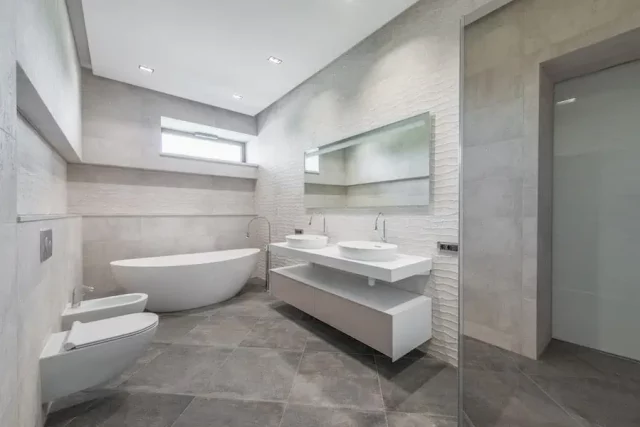The bathroom is a sanctuary where we begin and end our day, making it essential to carefully select the right floor material that enhances its overall design and functionality. The bathroom floor must withstand constant exposure to moisture, and frequent foot traffic, and provide a safe and comfortable surface. With a myriad of options available in the market, choosing the ideal bathroom floor material can be a daunting task. In this blog post, we will delve into eight essential factors to consider when selecting bathroom floor materials, ensuring that you make an informed decision that meets your style, durability, and maintenance requirements.
Water Resistance
The bathroom is a high-moisture environment, prone to spills, humidity, and splashes. It is crucial to choose a flooring material that can withstand these conditions and remain resilient over time. Opt for materials with inherent water-resistant properties, such as ceramic tiles, vinyl, or natural stone. Ceramic and porcelain tiles are highly resistant to water, making them a popular choice for bathrooms. These materials have low water absorption rates and are easy to clean, ensuring that water does not seep through and cause damage to the underlying structure. Vinyl flooring, particularly luxury vinyl planks, is also a great option as it provides excellent waterproofing capabilities. It has a non-porous surface that repels water, preventing it from penetrating the floor. Natural stones like granite or marble can be water-resistant with proper sealing, creating a protective barrier against moisture.
Durability
Bathroom floors are subjected to constant foot traffic, as well as exposure to various substances like cleaning agents, cosmetics, and personal care products. To ensure longevity and minimize the need for frequent repairs or replacements, durability is a key factor to consider. Porcelain and ceramic tiles for bathrooms are renowned for their durability, as they can withstand heavy use without showing signs of wear. These materials are resistant to scratches, dents, and stains, making them an excellent choice for bathrooms. Their dense composition ensures that they retain their original appearance and structural integrity over time. Another excellent option is a natural stone, such as granite or marble, which offers exceptional durability and can withstand the test of time. These materials are highly resistant to impact, making them suitable for areas with high foot traffic.
Slip Resistance
Safety should always be a primary concern when selecting bathroom floor materials. Bathrooms can be accident-prone areas due to wet surfaces. It is crucial to choose a flooring material that offers good slip resistance to reduce the risk of falls. Textured ceramic or porcelain tiles with a high coefficient of friction provide better traction, making them an excellent choice for bathroom floors. These tiles have a slightly rougher surface that enhances grip, even when wet. The texture helps create friction between the foot and the floor, reducing the chances of slipping. Additionally, some tiles come with slip-resistant coatings that further enhance their safety. Alternatively, non-slip vinyl or rubber flooring can also be considered for its slip-resistant properties. They have a softer surface that provides better traction and minimizes the risk of accidents.
Maintenance
Ease of maintenance is an important consideration for bathroom floors. Bathrooms require regular cleaning due to moisture and hygiene concerns. It is advisable to choose a flooring material that is easy to clean and maintain, saving you time and effort. Porcelain and ceramic tiles are relatively easy to clean, requiring simple regular maintenance with mild cleansers. Their smooth and non-porous surfaces make them resistant to staining and allow for easy removal of dirt and grime. Natural stone floors may require periodic sealing to protect them from stains and water damage. This sealing process helps maintain their appearance and prevents moisture penetration. However, materials like hardwood or carpeting are less suitable for bathrooms as they are more prone to water damage and can be challenging to clean effectively.
Style And Aesthetics
The bathroom floor sets the tone for the overall design and ambiance of the space. When selecting a flooring material, consider the style and aesthetics you want to achieve. Tiles offer a wide range of options, including different colors, patterns, and sizes, allowing you to create a personalized look. Ceramic or porcelain tiles can be selected in various styles, from classic to modern, to match your desired design theme. You can choose from a variety of tile patterns, such as subway, mosaic, or geometric designs, to add visual interest to your bathroom. Natural stone floorings, such as marble or slate, exudes elegance and can bring a touch of luxury to your bathroom. The unique patterns and textures of natural stone create a sophisticated and timeless appearance. It is essential to ensure that the chosen material complements the overall design theme and color scheme of your bathroom, creating a cohesive and visually appealing space.
Comfort And Warmth
Stepping onto a cold floor can be uncomfortable, especially during colder months or in colder climates. Considering the comfort and warmth provided by the flooring material is important to enhance your bathroom experience. While tiles can be cold, underfloor heating systems can be installed to mitigate this issue. Radiant heating can provide warmth and comfort underfoot, making the tile surface more enjoyable. With the warmth radiating from the floor, stepping out of the shower or bath becomes a cozy experience. Additionally, materials like vinyl or cork flooring offer a softer and warmer feel underfoot, providing a more comfortable experience for those who spend extended periods in the bathroom. Vinyl flooring has a slightly cushioned surface that adds a layer of comfort and warmth, while cork flooring has natural thermal insulation properties, making it warm and pleasant to walk on.
Budget
Setting a budget for your bathroom flooring project is crucial to narrow down your options and finding a material that fits within your financial constraints. Different flooring materials vary greatly in terms of cost, and it’s essential to find a balance between your desired aesthetic and your budget. Porcelain and ceramic tiles are generally more affordable options, offering durability and versatility at a reasonable price point. These materials are widely available and come in various price ranges, allowing you to choose options that suit your budget. Natural stone floors, while elegant and durable, can be more expensive due to their uniqueness and quality. The cost of natural stone can vary depending on the type and rarity of the stone. If you’re working with a tighter budget, vinyl, and linoleum are budget-friendly choices that still offer durability and a variety of design options. These materials are cost-effective alternatives that can mimic the appearance of more expensive materials without compromising on quality.
Eco-Friendliness
For those who prioritize sustainable choices and environmental impact, look for options that minimize harm to the environment and promote sustainability. Recycled tiles, for instance, are made from post-consumer materials, such as glass or porcelain, reducing the consumption of new resources. These tiles contribute to waste reduction and offer unique textures and patterns. Bamboo flooring is another sustainable option as it is a rapidly renewable resource. Bamboo reaches maturity within a few years, making it an environmentally friendly choice compared to traditional hardwood. Cork flooring, derived from the bark of the cork oak tree, is not only sustainable but also offers natural sound and thermal insulation properties. Cork harvesting is done without harming the tree, allowing it to regenerate and absorb more carbon dioxide. Additionally, check if the manufacturer follows sustainable production practices and uses non-toxic materials, ensuring that the chosen flooring material aligns with your eco-friendly values.
Choosing the right bathroom floor material requires careful consideration of factors such as water resistance, durability, slip resistance, maintenance, style, comfort, budget, and eco-friendliness. By weighing these essential factors and understanding your personal preferences, you can select a bathroom floor material that not only enhances the aesthetics of your space but also provides the necessary functionality and longevity. Remember that investing in a high-quality bathroom floor will pay off in the long run, making your daily routines more enjoyable while adding value to your home.














